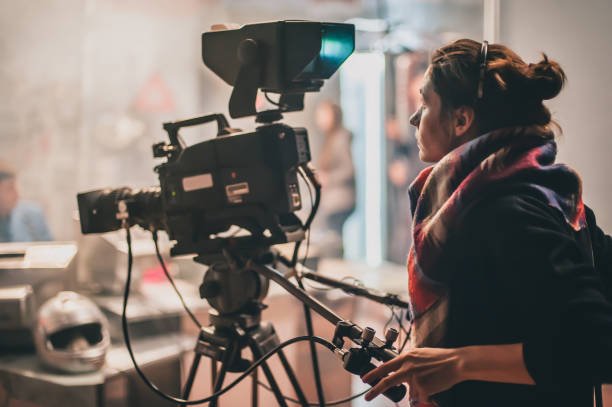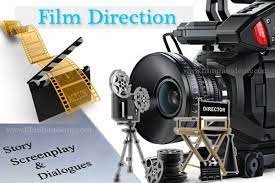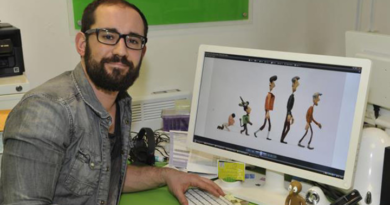Free Film Direction Courses (1 Year Diploma)

Free Film Direction Courses (1 Year Diploma) Diploma Director of Photography in
the Media & Entertainment Industry is also known as the DoP and is the head of the camera department
Brief Job Description: Individuals at this job need to determine the visual style of the production.
They finalise locations and equipment that will be used. During shoots, they guide efforts of the
camera crew and collaborate with lighting and grips to capture the desired look for the end-
product.Free Film Direction Courses (1 Year Diploma)
Personal Attributes: This job requires the individual to assess the visual style of the production.
The individual must be creative and detail-oriented. The individual must know and keep updated
on the various camera equipment, shooting techniques and mediums. The individual must have
excellent communication skills and must possess the ability to guide efforts and work collaboratively.
The individual must be flexible and able to make key decisions, keeping in mind the impact on cost and timelines.
Free Film Direction Courses (1 Year Diploma) to watch in video mode.
Free Film Direction Courses (1 Year Diploma) :-

Visual style
Visual style comprises the look or appearance of the production including the lighting,
colors, shadows, sets, costumes, locations and the way they will be captured on screen.
Creative brief
Creative brief is a document that captures the key questions that serve as a guide for the
production including the vision, objective of the project, target audience, timelines, budgets,
milestones, stakeholders etc.
Shoot schedule
Shoot schedule is a listing of the sequences/shots that need to be captured on each shoot day
Multi-camera
Multi-camera is a method of shooting where multiple cameras are used to simultaneously
capture different views/images
Budget
Budget is an estimate of the total cost of production that may include a break-up of cost
components
Timelines
Timelines is a listing of dates by which the production milestones/stages need to be completed
Continuity
Continuity represents the seemless transition from one shot to another
Script Free Film Direction Courses (1 Year Diploma)
Script is a structured narrative of a story
Screenplay
Screenplay is the script coupled with key characteristics of the scene and directions for acting
Post-production
Post-production is the final finishing phase of the production, where the raw footage is edited,
special effects are added, music and sound are integrated, color correction is done etc.
Color grading
Color grading is the process of enhancing and correcting the colours of the final production
Digital intermediate
Digital intermediate is the process where a film is digitised and the colour and image characteristics are modified
Recce
Recce is a detailed visual and technical assessment of the attributes and suitability of a particular
location for the shoot, usually through a personal visit
Grips Free Film Direction Courses (1 Year Diploma)
Grips is the department that specialises in mounting the camera on to tripods, dollies, cranes and other platforms for shoots
Jib
Jib is a device used for the movement of camera and operates like a see-saw, with the camera at one
end and the camera controls at the other
Lenses
Lenses are used to capture images and are attached on to the body of the camera
Filters
Filters are used to alter the properties of light entering the camera lens. They are also used to create
a number of special effects
Dolly
Dolly is a platform with wheels on which the camera can be mounted and moved around during the shoots
Magazines
Magazines are compartments within a camera that are used to hold the film tape
Clapper board
Clapper board is a slate that has information pertaining to each shot, used as a guide to mark shots
and aid matching image with sounds Definitions

Free Film Direction Courses (1 Year Diploma) Lens:-

Free Film Direction Courses (1 Year Diploma) Focus length
Focus length is the angle of view from the lens
Framing
Framing is how the artists, objects, sets, locations etc. are positioned within the camera view for a single shot
Master shot
Also known as a cover shot, this shot is a long sequence that establishes an overview and
aids assembly of smaller, closer shots with details
Sector
Sector is a conglomeration of different business operations having similar businesses and interests.
It may also be defined as a distinct subset of the economy whose components share similar characteristics and interests.
Sub-sector
Sub-sector is derived from a further breakdown based on the characteristics and interests of its components.
Vertical
Vertical may exist within a sub-sector representing different domain areas or the client industries
served by the industry.
Occupation
Occupation is a set of job roles, which perform similar/related set of functions in an industry
Function
Function is an activity necessary for achieving the key purpose of the sector, occupation, or area of work,
which can be carried out by a person or a group of persons. Functions are identified through functional
analysis and form the basis of OS.
Sub-functions
Sub-functions are sub-activities essential to fulfill the achieving the objectives of the function.
Job role
Job role defines a unique set of functions that together form a unique employment opportunity in an organization.
Occupational Standards (OS)
OS specify the standards of performance an individual must achieve when carrying out a function in
the workplace, together with the knowledge and understanding they need to meet that standard consistently.
Occupational Standards are applicable both in the Indian and global contexts.
Performance Criteria
Performance Criteria are statements that together specify the standard of performance required when carrying out a task
National Occupational Standards (NOS)
NOS are Occupational Standards which apply uniquely in the Indian context.
Qualifications Pack Code
Qualifications Pack Code is a unique reference code that identifies a qualifications pack.
Free Film Direction Courses (1 Year Diploma)
Qualifications Pack comprises the set of OS, together with the educational, training and other criteria
required to perform a job role. A Qualifications Pack is assigned a unique qualification pack code.
Unit Code
Unit Code is a unique identifier for an Occupational Standard , which isdenoted by an ‘N’.
Unit Title
Unit Title gives a clear overall statement about what the incumbent should be able to do.
Description
Description gives a short summary of the unit content. This would be helpful to anyone searching on
a database to verify that this is the appropriate OS they are looking for.
Scope
Scope is the set of statements specifying the range of variables that an individual may have to deal with
in carrying out the function.
Knowledge and Understanding
Knowledge and Understanding are statements which together specify the technical, generic, professional and
organizational specific knowledge that an individual needs in order to perform to the required standard.
Organizational Context
Organizational Context includes the way the organization is structured and how it operates, including the extent of
operative knowledge managers have of their relevant areas of responsibility.
Technical Knowledge
Technical Knowledge is the specific knowledge needed to accomplish specific designated responsibilities.
Core Skills/Generic Skills
Core Skills or Generic Skills are a group of skills that are key to learning and working in today’s world. These skills are
typically needed in any work environment. In the context of the OS , these include communication related skills that
are applicable to most job roles.

Free Film Direction Courses (1 Year Diploma):-
A. Organizational Context (Knowledge of the company / organization and its processes) The user/individual on
the job needs to know and understand: KA1. The creative and technical requirements of the production KA2.
The technical, budget and time constraints applicable KA3. The role and contribution of key departments be
liaised with, especially lighting and grips where the camera team has the maximum interaction B. Technical Knowledge
The user/individual on the job needs to know and understand: KB1. Various camera techniques and shooting medium (digital/tape/film) KB2. How to assess the visual style of production from the script and through discussions with the producer, director KB3.
How to identify inconsistencies between the story, dialogue and resulting action and apparent continuity issues KB4.
How to break-down the script into sequences and shots and list out detailed characteristics of each shot e.g.
day/afternoon/night scene, mood of the shot, special effects required etc. KB5. How to estimate the cost and
time it would take for shoots keeping in mind the intended visual style for production
Free Film Direction Courses (1 Year Diploma) KB6. How to determine the number of shots that can be covered
on each day and detail out the day-wise shoot plan, keeping in mind the production budget, time and technical
constraints KB7. How to modify the camera plan in accordance to production requirements KB8. Applicable health
and safety guidelines, and ensuring that the style selected minimizes any risks to the health and safety of the cast
and crew Skills (S) (Optional) A. Core Skills/ Generic Skills Writing Skills
The user/individual on the job needs to know and understand how to:
SA1. Document ideas to help present to the producer and director
SA2. Document the day-wise shoot schedule including the scenes/shots to be covered, type of
shoot and key characteristics for each shoot
SA3. Prepare guidelines for other departments to maintain continuity during shoots Reading Skills
The user/individual on the job needs to know and understand how to: SA4. Read and understand
the script and screenplay thoroughly SA5. Read and understand the production budget and timelines
SA6. Research creative ways to visually depict the film by looking at productions worked on in the past,
as well as other releases from the public domain SA7. Research innovative shooting styles and techniques
that may be applied to the current production, keeping in mind the technical and budgetary constraints Oral
Communication (Listening and Speaking skills)
The user/individual on the job needs to know and understand how to:
SA8. Discuss, clarify and confirm the visual and technical requirements of production with the producer and director
SA9. Present ideas and gain consensus on the visual style of the production with the producer and director
SA10. Discuss and agree on the shoot plan with the producer and director B. Professional Skills Decision Making
The user/individual on the job needs to know and understand how to: SB1. Make decisions related to the way the
script will be represented visually SB2. Determine the way the script will be represented visually, in conjunction
with the producer and director Plan and Organize The user/individual on the job needs to know and understand
how to: SB3. Create a day-wise shoot plan including the number of shots to be covered on each day Problem Solving
The user/individual on the job needs to know and understand how to:
SB4. Identify any problems with successful execution of the task and resolve them in consultation with the producer and director
Analytical Thinking of Free Film Direction Courses (1 Year Diploma)
The user/individual on the job needs to know and understand how to:
SB5. Envision the impact of selecting a particular shoot type on the production budget and key activities
SB6. Envision the impact of selecting a particular shoot type on post-production process and implications
on colour grading and digital intermediate
SB7. Critical thinking
The user/individual on the job needs to know and understand how to:
SB8. Highlight inconsistencies between the story, dialogue and resulting action and apparent continuity issues
SB9. identify the equipment requirements from the production brief which can enhance the agreed visual
style and brief Customer Centricity
The user/individual on the job needs to know and understand how to:
SB10. Check that own and/or your peer’s work meets customer/project requirements.
Skills (S) (Optional) A. Core Skills/ Generic Skills Writing Skills
The user/individual on the job needs to know and understand how to:
SA1. Document the pros and cons of each location and reasons for choosing/rejecting any location
SA2. Document additional technical and equipment needs at the location, for reference of the relevant
departments Reading Skills
The user/individual on the job needs to know and understand how to:
SA3. Read about the location, climate and environment factors during the intended shoot duration and time
SA4. Read the production budgets to ensure that the location and ancillary costs stay in line Oral Communication
(Listening and Speaking skills)
The user/individual on the job needs to know and understand how to:
SA5. Liaise with production department to discuss suitability of the location with respect to the production needs,
expected problems that might arise, additional requirements, if any.Free Film Direction Courses (1 Year Diploma)
SA6. Discuss and confirm the creative and technical requirements of the camera team with the production team
SA7. Communicate any health and safety requirements to the production team and assign responsibility for needs to
be taken care of B. Professional Skills Problem Solving The user/individual on the job needs to know and understand how to: SB1. Identify problems with successful execution at the location and resolve them in consultation with the production team Decision making The user/individual on the job needs to know and understand how to: SB2. Decide whether the location is of a suitable size and terrain to allow for production requirements or not SB3. Decide that technical facilities on location are sufficient to meet camera requirements Plan and Organize The user/individual on the job needs to know and understand how to: SB4. Plan logistics of transportation, access and set-up, and moving from one location to another, are feasible in relation to the production schedule Customer Centricity The user/individual on the job needs to know and understand how to: SB5. Free Film Direction Courses (1 Year Diploma) Check/confirm that.










